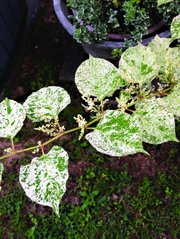Q Please give me some do's and don'ts regarding exposed roots of a tree. I love the canopy of this maple I planted from a seed from upstate Virginia a dozen or so years ago. May I safely establish a steel edging border and fill it with bark mulch? Would it be safe to sever exposed roots a dozen feet or less from the tree? What would the minimum distance be for cuts? The farthest exposed roots must be 20 feet from the tree.
A Certain trees are simply prone to surface roots, and maples lead the pack. When there is limited soil for the roots to grow in (next to a street or sidewalk) surface roots will be even more numerous. Cutting the roots could damage the tree, and in any event, more will grow back. It is best simply to mulch the area. Mulch will allow oxygen and water these roots need to make it through, unlike soil, which has smaller pore spaces. Where you have grass growing you can add a bit of soil to cover those exposed roots that are farther away from the tree canopy so the grass or groundcover will buffer them.
Q I have six crape myrtles that are 10 to 12 feet tall and have bloomed for the last five years. This year one has lots of blooms and the others have none. They are green and healthy looking. Do some bloom at different times? I don't remember them doing that, but maybe I did not pay close attention.
A There can be some variation to blooming of crape myrtles based on variety, amount of sunlight they receive, age of the tree and how much or how little they were pruned. If they are getting at least 8 hours of sunlight a day, they should bloom. I would check for crape myrtle bark scale damage on the trunks. We have found that a heavy infestation does limit blooming.
Q Recently I had to replace a shrub, and it involved digging up about two dozen daffodil bulbs. These are no ordinary bulbs. I moved them from my grandmother's yard in northeast Arkansas. They are about 50 years old and precious to me. Now they are tied up in old pantyhose and in our garage. Can they safely stay there until fall planting time? Should they be in my refrigerator? Should I replant them? Please advise me -- I just cannot lose them.
A Your daffodil bulbs should be fine stored as they are until fall planting. Keep them in a cool, dry place until then. We normally start planting spring bulbs in October and finish in December. Check the bulbs periodically. If any of the bulbs were injured while you were digging, they can deteriorate. I also hope you dried them for about a week after digging. I have stored some in a cardboard box that I filled with shredded paper or shipping peanuts and then stored in my garage on a shelf. If they were really wet when you put them in the pantyhose they could mold, so check them and see how they look. They should be relatively dry and firm to the touch.
Q Summer is heating up and so is my frustration with people and their need to water. My neighbor, after more than 20 inches of rain, was watering her grass after mowing. I asked her, "Why?" She said because she was watering-in the fertilizer that was on the cut grass. I thought, maybe, in an article, you could explain that all she was doing was watering her grass. I could have explained that the cut grass would decompose and the nutrients from past fertilizations would then go into the soil. I have 5,000 square feet of lawn and never, ever water all summer. If a lawn has a healthy root system, people don't need to water. But, why am I telling you this. You already know. Water is a precious resource. People all over the world are dying because they do not have clean water.
A There are definitely people who overwater, and some who don't water enough. If you have a well-established Bermuda grass lawn with great soil, then you can get by without watering even in a dry summer. In my first house, we had great soil, lived on a level lot, and I rarely watered. The yard I have now is on a slope with a ton of rocks. While I amend the beds, there is still a need for me to water my vegetables and flowers regularly. I don't water my zoysia that often, as lawns are typically more tolerant. Recycling yard waste is also recycling nutrition. Many people overfertilize their lawns too. I think it all comes down to what you are growing, spacing of plants, soil type, amount of sunlight and age of plants. My pet peeve is sprinklers going off in a pouring rain. We all need to be conscious of how much water we are using and make sure we use it properly to conserve what we have.
Q What is this variegated plant? [Reader enclosed picture.] It grows very well in my garden, and I am considering getting more.
A The common name is Mexican bamboo (Polygonum cuspidatum). While it is not a true bamboo it can become invasive, as bamboo is. It is actually in the buckwheat family. It is also called Japanese knotweed.
Janet B. Carson is a horticulture specialist for the University of Arkansas Cooperative Extension Service. Write to her at 2301 S. University Ave., Little Rock, Ark. 72204 or email her at
jcarson@arkansasonline.com
HomeStyle on 06/24/2017

